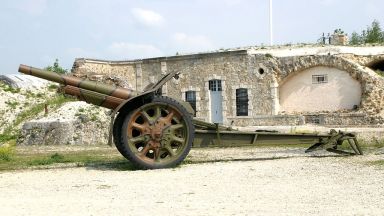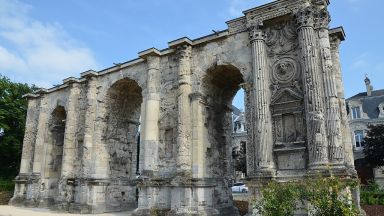Fort de la Pompelle
Historic Site and Museum in Reims

The Fort de la Pompelle, also known as Fort Herbillon, was constructed around Reims after 1870 as a part of a fortification belt in the Séré de Rivières system. It played a crucial role during the First World War in defending Reims. Situated roughly 2 kilometers north of Sillery, it is adjacent to the N44 road, which connects Reims and Châlons-en-Champagne. Designed to bolster larger forts and decommissioned in 1913, this fort witnessed the most intense combat among the Reims forts. It was heavily bombarded during the war and now stands in ruins.
Constructed between 1880 and 1883, the Fort de la Pompelle was established to enhance the fortifications around Reims, initiated by General Raymond Adolphe Séré de Rivières following the Franco-Prussian War of 1870. It was envisioned to support the main forts including Witry-les-Reims, Nogent-l’Abbesse, Brimont, Saint-Thierry, Fresnes, and Montbré. This modestly sized rectangular fort was encircled by a ditch, protected by two-tier caponiers. Spread across 2.31 hectares, the fort was armed with six 155mm de Bange 1881 guns, four 138mm guns, and various smaller armaments. An artillery company consisting of 277 men manned the fort. Between 1917 and 1918, numerous underground passages were carved from the chalk to create entry points a few hundred meters behind the fort.
The fort’s armaments were removed in 1913, just before the onset of the First World War. In 1914, German troops briefly occupied the fort on 4 September. However, after the First Battle of the Marne, French troops from the 138th Infantry Regiment reclaimed it on 24 September 1914. The fort became a key component in the defence of the Reims sector. Throughout the war, the Germans attempted and bombarded the fort several times, but its control remained unchanged.
180 distinct regiments, inclusive of two unique Russian brigades sent in 1916 by Tsar Nicholas II, took turns defending the fort. The fort’s defenders received support from naval artillery situated on the canal between Sept Saulx and Courmelois, targeting the German frontlines. The fort faced fierce attacks in 1918 during the Second Battle of the Marne, being targeted three times, including on 1 June with fifteen tanks. However, the assaults were thwarted by the 1st Colonial Infantry Corps.
The fort’s significance was also captured in the 1931 Raymond Bernard film, Le Croix de Bois.
Abandonment and Restoration: After the war, the Fort de la Pompelle was deserted for almost four decades. In November 1955, it was set up for sale by the Administration des Domaines. Eventually, with the backing of veterans’ associations, the Fédération Nationale André Maginot acquired the fort and later sold it to the city of Reims for a symbolic franc.
Musée du Fort de la Pompelle: Recognized as a historic monument on 23 March 1922, the fort has since been transformed into a museum, which was inaugurated on 10 November 1972. The museum boasts a unique collection of German army headgear, gathered by Charles Freise.
The Fort de la Pompelle appears in our Complete Guide to Visiting Reims!
This website uses affiliate links which may earn a commission at no additional cost to you!
Visiting Fort de la Pompelle
10 a.m. to 6 p.m.
Closed on Mondays
€5.50
Nearby Attractions
- Parc de Champagne (6.0) km
Park in Reims - Maison Ruinart (6.3) km
Vinyard in Reims - Champagne Pommery (6.4) km
Historic Site in Reims - Villa Demoiselle (6.5) km
Historic Building in Reims - Maison Veuve Clicquot (6.6) km
Historic Site in Reims - Taittinger (6.8) km
Historic Site in Reims - Reims Champagne Automobile Museum (6.9) km
Museum in Reims - Basilique Saint-Rémi (7.0) km
Church in Reims - Musée Saint-Rémi (7.1) km
Museum in Reims - Bibliothèque Carnegie (7.9) km
Historic Building and Library in Reims


